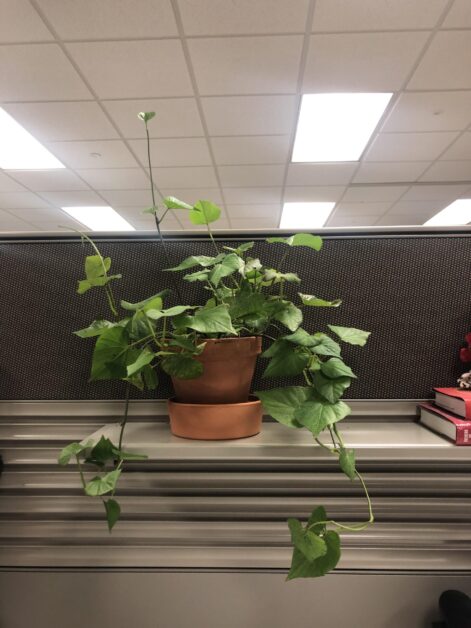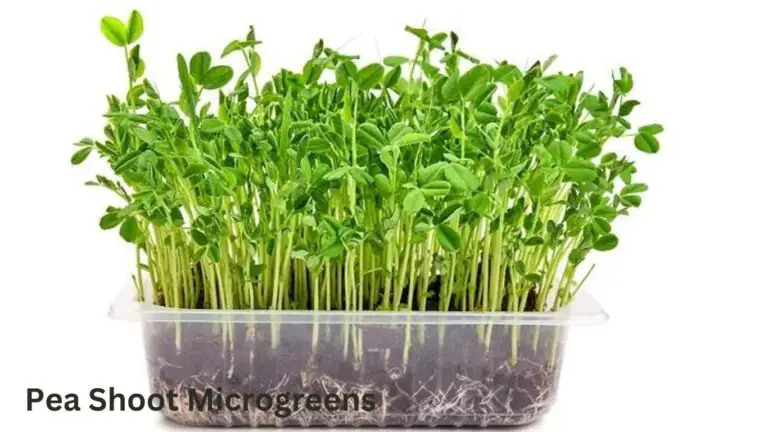How to Grow Sweet Potato Vines Indoors and Enjoy Their Beauty
Ever wondered if you could bring the lush beauty of sweet potato vines indoors? Well, wonder no more! Not only are sweet potato vines stunningly beautiful, but they’re also surprisingly easy to grow inside your home. Picture this: cascading foliage in vibrant greens and purples adorning your living space, adding a touch of nature’s elegance to your indoor oasis. But how exactly do you go about nurturing these gorgeous vines?
Fear not, as we’ve got you covered with expert tips and tricks to ensure your sweet potato vines thrive indoors. Get ready to embark on a journey of botanical beauty right in your own home!
Table of Contents
Benefits of Growing Sweet Potato Vines Indoors
Growing sweet potato vines indoors offers a multitude of benefits for gardening enthusiasts.
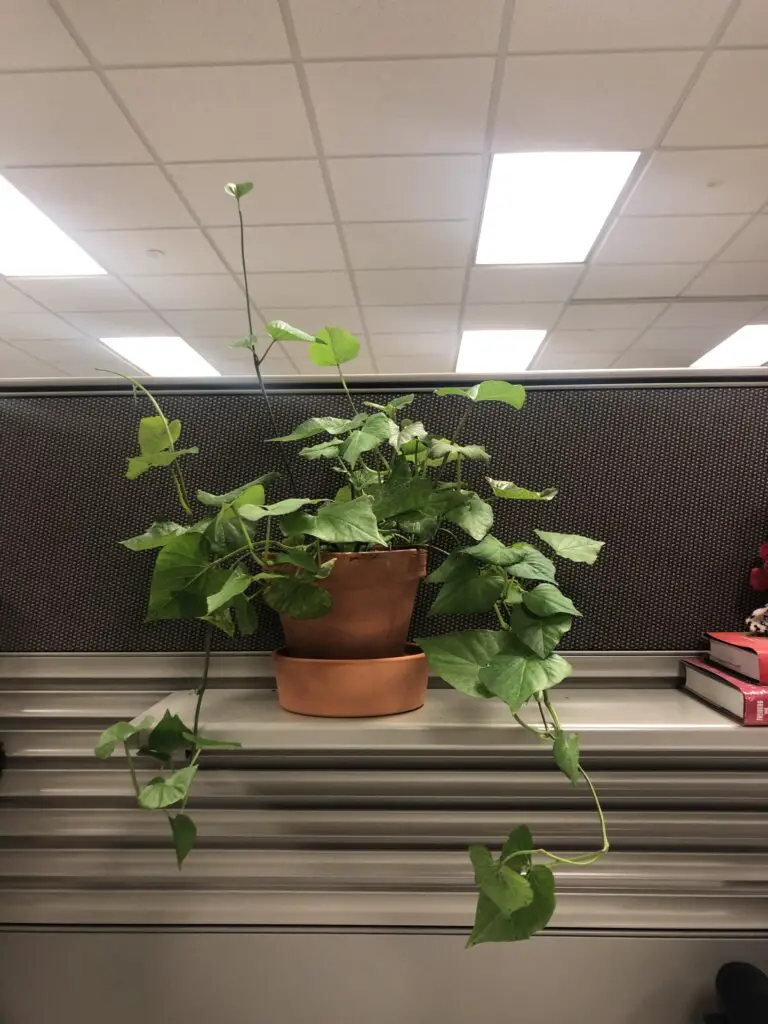
- Extended Growing Season: Indoor cultivation allows you to grow sweet potato year-round, regardless of outdoor weather conditions.
- Stable Environment: By bringing plants indoors, you create a stable environment with consistent temperatures and protection from frost.
- Controlled Growing Conditions: You can adjust factors like lighting, humidity, and soil quality to meet the specific needs of sweet potato varieties.
- Healthier Plants: Indoor cultivation results in healthier and more robust sweet potato vines.
- Reduced Pest and Disease Risk: Growing indoors minimizes the risk of pests and diseases commonly encountered in outdoor gardening.
Remember to provide proper care and maintenance to ensure thriving sweet potato vines and bountiful harvests! 🌱🍠
Selecting the Ideal Sweet Potato Variety for Indoor Growth
When selecting the ideal sweet potato variety for indoor growth, there are several factors to consider. First and foremost, it is important to choose a variety that is well-suited for container gardening.
| Variety | Advantages | Disadvantages | Characteristics |
|---|---|---|---|
| Beauregard | – High yield and excellent flavor | – Requires ample space due to vigorous growth | – Orange-fleshed tubers |
| – Resistant to pests and diseases | – Longer maturity period (around 100 days) | – Widely adapted and popular in home gardens | |
| Georgia Jet | – Early maturing (around 90 days) | – Smaller tubers compared to some other varieties | – Reddish-purple skin with orange flesh |
| – Compact growth habit, suitable for containers | – May need additional support for sprawling vines | – Good for northern climates | |
| Vardaman | – Compact vines, ideal for limited space | – Smaller tubers | – Light orange skin and flesh |
| – Shorter growing season (around 90 days) | – Less vigorous growth | – Well-suited for indoor cultivation |
In conclusion, selecting the ideal sweet potato variety for indoor growth requires careful consideration of factors such as growth habit, container suitability, and climate tolerance. By choosing a variety that fits these criteria, you can ensure a successful and fruitful indoor sweet potato garden.
Preparing the Soil for Indoor Sweet Potato Vines
Preparing the soil is a crucial step in the successful growth of sweet potato vines indoors. The quality and composition of the soil will directly affect the growth, health, and yield of your plants. When it comes to indoor gardening, the goal is to recreate the ideal growing conditions that sweet potatoes need to thrive. Start by choosing a well-draining potting mix that is specifically formulated for vegetable plants.

- Choose the Right Potting Mix:
- Select a well-draining mix to prevent waterlogging.
- Ensure it contains organic matter (compost or aged manure) for nutrients.
- Add Slow-Release Fertilizer:
- Sweet potatoes are heavy feeders, so mix in a slow-release fertilizer.
- This enhances nutrient availability during the growing season.
- Sterilize the Soil:
- Bake the soil at 180°F (82°C) for 30 minutes to kill pathogens, weed seeds, and insect eggs.
- Allow the soil to cool completely before planting.
Remember, healthy soil is the foundation for healthy plants, so investing time and effort in preparing the soil will greatly benefit the growth and success of your indoor sweet potato vines.
After incorporating Jobe’s Organics Compost Starter into my compost pile, I’ve seen remarkable improvements in the quality of my soil and the vitality of my plants. This product kickstarts the composting process effectively, thanks to its organic ingredients that foster beneficial microbial activity. The convenient packaging makes application a breeze, though there is a slight odor initially. With regular turning and maintenance, it’s proven to be a valuable addition to my gardening routine, providing the essential nutrients my plants need to thrive.
- Effectively jumpstarts composting process for nutrient-rich soil
- Organic ingredients promote healthy microbial activity
- Convenient packaging for easy application
- Ideal for enhancing soil fertility and plant growth
- Slight odor upon initial application
- Requires regular turning and maintenance for optimal results
Choosing the Right Container for Indoor Sweet Potato Vines
Choosing the right container for indoor sweet potato vines is crucial for their overall growth and development. The container you select should provide the necessary space for the sweet potato plants to spread their roots and allow for proper drainage. When it comes to container options, there are several factors to consider.

By carefully selecting the right container for your indoor sweet potato vines, you provide them with the optimal environment for healthy growth. Now that we’ve covered the importance of choosing the right container, let’s move on to the next step: planting sweet potato slips for indoor growth.
Having utilized the UOUZ Plastic Planter extensively in my gardening endeavors, I can confidently vouch for its reliability and versatility. Its durable construction has withstood the test of time, providing a stable home for my plants season after season. The 12-inch size accommodates a variety of flora, from vibrant flowers to fresh herbs and vegetables, allowing me to cultivate a diverse garden landscape.
The inclusion of drainage holes ensures proper water management, preventing the risk of overwatering and promoting healthy root development. While its plastic material may lack the elegance of ceramic or terracotta options, its practicality and affordability make it a standout choice for any outdoor garden. Overall, the UOUZ Plastic Planter has exceeded my expectations, delivering both functionality and durability to enhance my gardening experience.
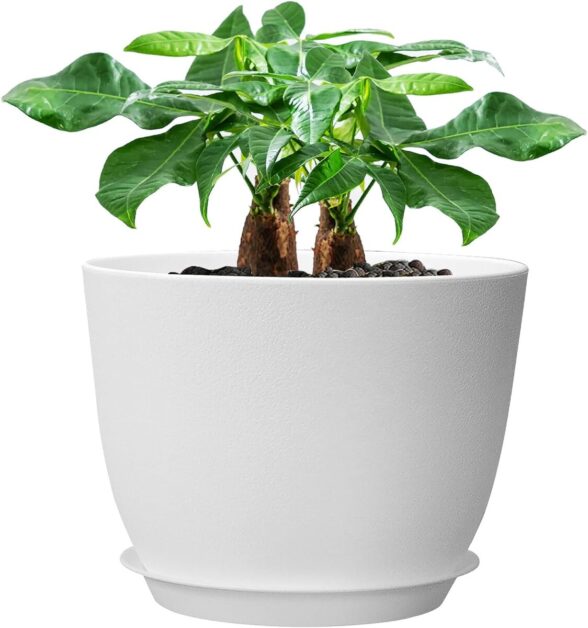
✅ 12-inch size suitable for planting various flowers, herbs, or vegetables
✅ Drainage holes prevent waterlogging and promote healthy root growth
✅ Lightweight design for easy transportation and placement in outdoor spaces
❌ Limited color options compared to other planters on the market
Planting Sweet Potato Slips for Indoor Growth

Sweet potato slips are the key to successfully growing sweet potato vines indoors. These young plantings are essentially shoots that have been grown from a sweet potato tuber.
- Prepare the soil: Ensure the soil is well-drained and loose, preferably sandy, with a slightly acidic pH level between 5.8 and 6.2.
- Dig holes: Make small holes in the soil, spacing them approximately 12 inches apart.
- Insert slips: Gently insert the sweet potato slips into the holes, burying them up to their first set of leaves.
- Space properly: Ensure proper spacing between the slips to allow for adequate growth and development.
- Encourage root system: Burying the slips up to their first set of leaves will promote the development of a sturdy root system.
- Water lightly: After planting, lightly water the soil to ensure proper hydration without over-saturating the roots.
By following these steps, you can ensure that your sweet potato slips are properly planted for indoor growth. With the right soil preparation and careful planting technique, you’ll set yourself up for success in cultivating healthy and vibrant sweet potato vines in your indoor gardening space.
Providing Optimal Lighting Conditions for Sweet Potato Vines Indoors
Providing optimal lighting conditions is crucial for the successful growth of sweet potato vines indoors. Sweet potato plants thrive in bright and direct sunlight, so it is important to ensure they receive sufficient light to support their growth and development.
- Choose a suitable location: Select a spot indoors that receives at least 6-8 hours of sunlight per day, preferably near a south-facing window for maximum sunlight exposure.
- Assess lighting options: If natural sunlight is limited, consider using artificial lighting such as LED grow lights to supplement. LED lights mimic natural sunlight and promote healthy growth.
- Install LED grow lights: Position LED grow lights approximately 6-12 inches above the sweet potato vines to ensure proper coverage and prevent legginess.
- Monitor light intensity: Use a light meter to measure the intensity of light, aiming for levels between 400-1000 µmol/m²/s for optimal growth.
- Adjust light duration: Maintain a consistent light cycle of 10-12 hours of light followed by 12-14 hours of darkness to simulate the natural day-night cycle.
- Regularly check lighting conditions: Continuously monitor light intensity and duration to ensure the sweet potato vines are receiving the ideal lighting conditions for healthy growth.
By ensuring your sweet potato vines receive the optimal lighting conditions, whether through natural sunlight or artificial lighting, you will provide them with the energy they need to flourish and produce a bountiful harvest indoors.
Watering and Fertilizing Indoor Sweet Potato Vines
Watering and fertilizing play a crucial role in the successful growth of indoor sweet potato vines. Proper hydration and nutrition are essential for the plant’s overall health and productivity. When it comes to watering, it’s important to strike a balance between not overwatering, which can lead to root rot, and not underwatering, which can cause the plants to wither and die.

- Watering:
- Water thoroughly but infrequently.
- Allow the soil to dry out slightly between watering sessions.
- Ensure water reaches the bottom of the container for root access.
- Soil Mix:
- Use a well-draining soil mix to prevent waterlogging.
- Promotes healthy root growth.
- Fertilization:
- Incorporate organic matter before planting for essential nutrients.
- Apply slow-release fertilizer with balanced NPK ratios once vines are established.
- Consider natural potassium sources (e.g., wood ash).
- Monitor for nutrient deficiencies, (yellowing leaves, stunted growth).
Remember, finding the right balance is key – over-fertilizing can damage the plants, while under-fertilizing can lead to poor growth and yield.
Proper watering and fertilizing are essential for the health and growth of indoor sweet potato vines. Here’s a concise guide:
| Watering and Fertilizing Indoor Sweet Potato Vines | Watering Tips | Fertilizing Tips |
|---|---|---|
| Watering Frequency | – Consistency: Maintain a consistent watering schedule. | – Balanced Fertilizer: Use a balanced, all-purpose fertilizer. |
| – Moisture Level: Keep the soil consistently moist. | – NPK Ratio: Choose a fertilizer with a balanced NPK ratio (e.g., 10-10-10). | |
| – Avoid Waterlogging: Ensure proper drainage to prevent waterlogging. | – Application Frequency: Apply fertilizer every 4-6 weeks during the growing season. | |
| Watering Method | – Deep Watering: Water deeply, allowing water to reach the root zone. | – Dilution: Dilute the fertilizer to half or quarter strength to avoid over-fertilization. |
| – Bottom Watering: Water from the bottom to encourage root growth. | – Organic Options: Consider using organic fertilizers for a gradual release of nutrients. | |
| – Monitor Soil Moisture: Check soil moisture regularly to adjust watering. | – Avoid Over-Fertilization: Over-fertilizing can lead to nutrient imbalances and harm the plants. | |
| Water Quality | – Use Room-Temperature Water: Avoid cold water; use room-temperature water. | – Follow Package Instructions: Adhere to the recommended application rates on the fertilizer package. |
| – Avoid Chlorinated Water: Allow tap water to sit for a day to dissipate chlorine. | ||
| – Rainwater Preference: If possible, use collected rainwater. | ||
| Signs of Overwatering or Underwatering | – Yellowing Leaves: Yellowing may indicate overwatering. | – Leaf Color and Growth: Monitor leaf color and overall growth for signs of nutrient deficiencies. |
| – Wilting: Wilting may indicate underwatering. | – Adjust as Needed: Adjust watering and fertilizing based on plant responses. |
Managing Temperature and Humidity for Successful Indoor Growth
Achieving the right temperature and humidity levels is crucial for the successful growth of sweet potato vines indoors.
By carefully managing the temperature and humidity levels, you can ensure the optimal conditions for successful growth of sweet potato vines indoors.
Pruning and Training Techniques for Beautiful Sweet Potato Vines
Pruning and training techniques are essential for maintaining the health and beauty of your indoor sweet potato vines. By properly pruning and training these vines, you can encourage optimal growth, prevent overcrowding, and create a visually appealing display.
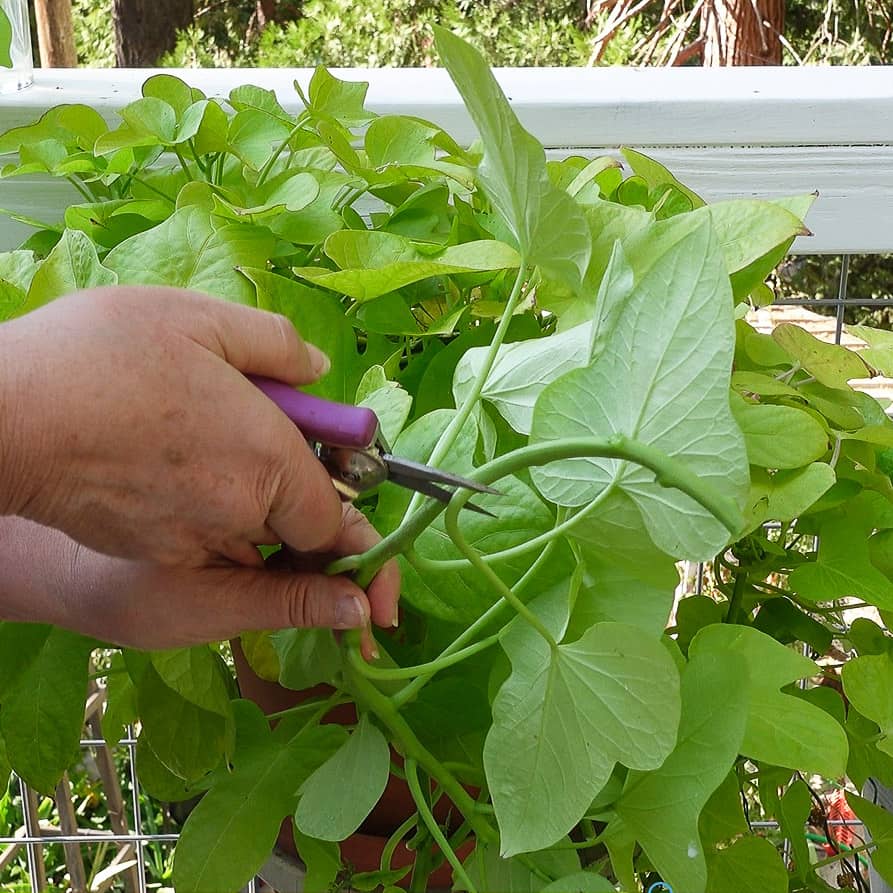
Certainly! Here are the key points for pruning and training sweet potato vines:
- Pruning:
- Regularly prune to control growth and prevent unruliness.
- Remove dead or damaged leaves throughout the growing season.
- Prune back excessive growth to maintain a compact, bushy shape.
- Be cautious not to remove too much foliage (important for photosynthesis).
- Training:
- Guide vines into desired forms or structures.
- Gently weave them around trellises, stakes, or wire frames.
- Start training early to prevent entanglement.
- Regularly check and adjust supports for proper growth direction.
By implementing proper pruning and training techniques, you can create beautiful and well-maintained sweet potato vines that will thrive in your indoor garden. Stay tuned for our next section on preventing and managing common pests and diseases that can affect your indoor sweet potato vines.
Preventing and Managing Common Pests and Diseases in Indoor Sweet Potato Vines
One of the key challenges in growing sweet potato vines indoors is preventing and managing common pests and diseases. While indoor environments may offer some protection against external threats, it’s still important to remain vigilant and take proactive measures to ensure the health and productivity of your plants.
| Pest/Disease | Symptoms | Treatment | Effect on Plant |
|---|---|---|---|
| Sweet Potato Weevil | – Eggs laid on vines- Larvae bore into sweet potatoes- Wilting and damage | – Regularly inspect vines- Remove affected tubers- Use insecticides if necessary | Damage to tubers and wilting of vines |
| Whiteflies | – Tiny insects feeding on plant sap- Can transmit sweet potato whitefly-transmitted viruses | – Use yellow sticky traps to monitor and control- Apply insecticides if infestation is severe | Transmission of viruses and weakening of plants |
| Aphids | – Sap-sucking insects causing stunted growth and distorted leaves | – Spray with soapy water or neem oil solution- Encourage natural predators like ladybugs | Stunted growth and leaf distortion |
| Golden Tortoise Beetles | – Leave holes in leaves- Attracted to chartreuse foliage | – Handpick beetles if feasible- Use insecticidal soap or neem oil- Maintain plant health | Leaf damage and aesthetic impact |
| Caterpillars | – Feeding on leaves | – Handpick caterpillars- Apply biological or chemical insecticides as needed | Defoliation and reduced photosynthesis |
| Sweet Potato Virus Disease (SPVD) | – Stunted growth- Distorted and chlorotic mottling of leaves | – Use virus-free planting material- Control insect vectors (whiteflies)- Remove infected plants | Severe stunting, leaf distortion, and reduced tuber yield |
Remember to monitor your sweet potato vines regularly and take appropriate action to prevent or manage these issues.
Harvesting and Storing Sweet Potatoes Grown Indoors
Harvesting and storing sweet potatoes grown indoors can be a rewarding experience for gardeners who want to enjoy the fruits of their labor throughout the year. When it comes to harvesting, timing is crucial. It is recommended to wait until the foliage begins to yellow and wither before harvesting the sweet potatoes. This usually occurs around 90 to 120 days after planting the slips.

- Harvesting:
- Gently dig around the base of the plant.
- Carefully lift the tubers out of the soil.
- Avoid damaging the delicate skin or growth points.
- Lay the sweet potatoes in a single layer to dry for a few hours to toughen the skin.
- Curing:
- Cure sweet potatoes for 10 to 14 days.
- Use a warm and humid environment (80-85°F or 27-29°C, 85-90% humidity).
- This process heals minor cuts and bruises and converts starches into sugars for a sweeter flavor.
- Storage:
- Transfer cured sweet potatoes to a cool, dark storage area.
- Maintain a temperature between 55-60°F (13-16°C).
- Avoid storing near fruits that release ethylene gas to prevent spoilage.
By properly timing the harvest and following appropriate storage techniques, you can savor the taste of freshly grown sweet potatoes from the comfort of your own home throughout the year. So why not give it a try and enjoy the satisfaction of growing and enjoying this nutritious and delicious vegetable?
Propagating Sweet Potato Vines for Continuous Indoor Growth
The propagation of sweet potato vines for continuous indoor growth is a rewarding endeavor for gardening enthusiasts. By propagating new vines from existing plants, you can ensure a constant supply of fresh sweet potato greens or vibrant ornamental vines. There are several methods of propagating sweet potato vines, but one of the simplest and most effective ways is through stem cuttings.
- Select healthy vines: Choose well-established vines from existing sweet potato plants for propagation.
- Cut stem sections: Use clean and sharp pruning shears to cut stem sections that are approximately 6-8 inches long, ensuring each cutting has at least two nodes.
- Trim leaves: Remove lower leaves from the cutting, leaving a few at the top to support the plant.
- Prepare container and soil: Fill a small container with a well-draining potting mix to plant the cutting.
- Plant cutting: Plant the cutting upright in the soil, burying the bottom node and ensuring the top nodes are above the soil surface.
- Maintain moisture and light: Keep the soil moist but not waterlogged, and place the container in a warm, brightly lit location with indirect sunlight.
- Monitor root development: Within a few weeks, new roots should begin to form from the buried node of the cutting.
- Transplant or train: Once roots have fully developed, transplant the young vine into a larger container or onto a trellis system for vertical growth.
- Continuously propagate: By propagating new vines regularly, you can maintain a constant supply of sweet potato greens or create a lush indoor garden filled with vibrant vines.
The table explains about how to propagate sweet potato vines for continuous indoor growth
| Propagating Sweet Potato Vines for Continuous Indoor Growth | Method | Steps |
|---|---|---|
| Growing from Sweet Potato Slips | – Purchase or Prepare Slips: Obtain or create sweet potato slips (small sprouts). | – Place sweet potatoes in water or soil until slips form, then separate them for planting. |
| Rooting Cuttings in Water | – Select Healthy Vines: Choose healthy vines with several nodes. | – Cut a segment with a node, place it in water, and wait for roots to develop before planting. |
| Rooting Cuttings in Soil | – Prepare Cuttings: Take cuttings with at least one node. | – Plant cuttings in well-draining soil, keeping the soil consistently moist until roots form. |
| Harvesting and Replanting Tubers | – Harvest Tubers: Dig up sweet potato tubers from the container. | – Select healthy tubers with sprouts and replant them in fresh soil for continued growth. |
Creative Ways to Display and Enjoy Indoor Sweet Potato Vines
One of the best things about growing sweet potato vines indoors is the opportunity to get creative with their display. These vibrant plants can add a touch of nature and beauty to any room, and there are several unique ways to showcase them.

- Utilize hanging baskets or macrame plant hangers: Opt for these options to suspend sweet potato vines from the ceiling, creating a stunning cascading effect while saving valuable floor space.
- Train vines to climb: Encourage vines to climb up trellises or lattice structures, transforming them into living tapestries that can serve as room dividers or wall accents.
- Explore display possibilities: Get creative with how you showcase indoor sweet potato vines, considering various arrangements and placements to maximize their decorative appeal.
- Embrace practical benefits: Recognize the practical advantages of growing sweet potato vines indoors, such as providing a convenient source of fresh and nutritious greens year-round.
- Harvest for consumption: Harvest the leaves for use in salads, stir-fries, or juicing to incorporate healthy greens into your diet in a cost-effective manner.
- Enhance indoor air quality: Enjoy the added benefit of improved indoor air quality, as sweet potato vines have been shown to reduce levels of harmful VOCs like formaldehyde and benzene, contributing to a healthier and more pleasant indoor environment.
So, whether you choose to display your sweet potato vines for their beauty or practicality, they are sure to bring joy and benefits to your indoor space.
Troubleshooting Common Issues with Indoor Sweet Potato Vines
Sweet potato vines can be a rewarding addition to any indoor garden, but like any plant, they can sometimes encounter issues.
- Inadequate Lighting:
- Issue: Sweet potato vines require full sunlight. If they don’t receive enough light, they may become leggy or fail to produce tubers.
- Solution: Place your sweet potato vines in a location that receives at least six to eight hours of direct sunlight each day. If natural light is limited, use grow lights to supplement.
- Overwatering:
- Issue: Consistent moisture is essential, but overwatering can lead to root rot and fungal diseases.
- Solution:
- Allow the top few inches of soil to dry out between waterings.
- Use well-draining soil and containers with proper drainage holes.
- Monitor soil moisture and adjust watering accordingly.
Remember to trim your sweet potato vines regularly to keep them in check, and you can even use the trimmed parts for propagation. Happy gardening! 🌿🍠
Watch the following video for more information:
FAQ
Why are the leaves of my indoor sweet potato vine turning yellow?
Yellow leaves on indoor sweet potato vines can be a sign of overwatering. Make sure to allow the soil to dry out slightly between waterings and ensure proper drainage in the container.
What should I do if my indoor sweet potato vine is not producing any tubers?
If your indoor sweet potato vine is not producing tubers, it may not be receiving enough sunlight. Sweet potatoes require at least six hours of direct sunlight each day. Consider moving your plant to a sunnier location or using artificial grow lights to provide adequate lighting.
How can I prevent my indoor sweet potato vine from becoming leggy?
To prevent a leggy indoor sweet potato vine, ensure it receives sufficient light. If the vine is stretching towards the light source, it may need to be rotated regularly or placed closer to a window. Pruning the vine back to encourage bushier growth can also help.
What should I do if my indoor sweet potato vine is infested with pests?
If your indoor sweet potato vine has pests, such as aphids or spider mites, try using a mild insecticidal soap or neem oil spray to control the infestation. Make sure to follow the instructions on the product label carefully.
How do I know when it’s time to harvest my indoor sweet potatoes?
Indoor sweet potatoes are typically ready for harvest when the foliage begins to yellow and die back. Carefully dig around the base of the plant to harvest the tubers. Allow them to cure in a warm, dry place for a week before storing.
Can I propagate my indoor sweet potato vine from cuttings?
Yes, you can propagate your indoor sweet potato vine from cuttings. Simply cut a healthy vine section with a node and place it in a glass of water. Roots will form, and you can then transfer the cutting to a pot with well-draining soil.
How often should I fertilize my indoor sweet potato vine?
Indoor sweet potato vines benefit from regular fertilization during the growing season. Use a balanced fertilizer every two to three weeks, following the package instructions for application rates.
How can I prevent diseases from affecting my indoor sweet potato vine?
To prevent diseases in your indoor sweet potato vine, make sure to provide good air circulation and avoid overwatering. Avoid wetting the foliage when watering and remove any infected leaves promptly to prevent the spread of disease.
Can I grow multiple sweet potato vines in one container indoors?
Yes, you can grow multiple sweet potato vines in one container indoors, as long as the container is spacious enough to accommodate their growth. Make sure to provide enough room for each vine to spread out and receive adequate sunlight.
Can I eat the leaves of my indoor sweet potato vine?
Yes, the leaves of sweet potato vines are edible and can be cooked and consumed. They are packed with nutrients and can be used in various dishes, such as salads, stir-fries, or soups.

Studied Agricultural Engineering-Plant Protection at University of California, Davis.
Head of Content writing team at Southelmontehydroponics.com

